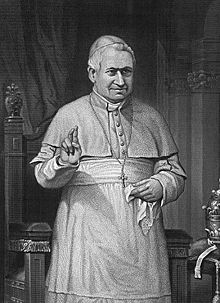

Beatification (from Latin beatus, "blessed" and facere, "to make") is a recognition accorded by the Catholic Church of a deceased person's entrance into Heaven and capacity to intercede on behalf of individuals who pray in their name. Beati is the plural form, referring to those who have undergone the process of beatification; they possess the title of "Blessed" /ˈblɛsɪd/ (abbreviation "Bl.") before their names and are often referred to in English as "a Blessed" or, plurally, "Blesseds".[1]
History
[edit]Local bishops had the power of beatifying until 1634, when Pope Urban VIII, in the apostolic constitution Cœlestis Jerusalem of 6 July, reserved the power of beatifying to the Holy See.[2][3]
Since the reforms of 1983, as a rule, one miracle must be confirmed to have taken place through the intercession of the person to be beatified. Miracles are almost always unexplainable medical healings, and are scientifically investigated by commissions comprising physicians and theologians.[4][5][6]
The requirement of a miracle for beatification is waived in the case of someone whose martyrdom is formally declared by the church.[7]
The feast day for a beatified person is not universal, but is celebrated only by territories, religious institutes, or communities in which the person receives particular veneration. For instance, Kateri Tekakwitha was especially honored in the United States and Canada during her time as Blessed. John Duns Scotus was honored among the Franciscans, in the Archdiocese of Cologne and other places. Similarly, veneration of Chiara Badano is particular to the Focolare movement.
The blessed, elected by popular acclamation (the vox populi) enjoyed only local veneration. While the procedure of canonization was taken in hand from the twelfth century by the papacy in Rome, that of beatification continued on a local scale until the thirteenth century before settling at the Council of Trent, which reserved to the pope the right to say who could be venerated.[8]
Practices under the popes
[edit]Pope John Paul II (1978–2005) markedly changed previous Catholic practice of beatification. By October 2004, he had beatified 1,340 people, more than the sum of all of his predecessors since Pope Sixtus V (1585–1590), who established a beatification procedure similar to that used today.[citation needed]
John Paul II's successor, Pope Benedict XVI (2005–2013), personally celebrated the Beatification Mass for his predecessor at St. Peter's Basilica, on the Second Sunday of Easter, or Divine Mercy Sunday, on 1 May 2011, an event that drew more than one million people.
See also
[edit]- Canonization (delineates the process of beatification)
- Chronological list of saints and blesseds
- List of saints
- List of venerated Catholics
- List of Servants of God
- List of beatified people
- List of people beatified by Pope Francis
- List of people beatified by Pope Benedict XVI
- List of people beatified by Pope John Paul II
References
[edit]Citations
[edit]- ^ "American Saints and Blesseds | USCCB". usccb.org. Retrieved 20 September 2020.
- ^ A. De Meester, Juris Canonici et Juris Canonico-Civilis Compendium Nova Editio, Tomus Tertius, Pars Secunda (Brugis: Desclée de Brouwer et Sii, 1928) p. 86 (citing the canonist Pope Benedict XIV, De Servorum Dei Beatificatione et Beatorum Canonizatione)
- ^ Beccari, Camillo (1907). "Beatification and Canonization." The Catholic Encyclopedia. Vol. 2. New York: Robert Appleton Company. Via New Advent. newadvent.org. Accessed 1 November 2015.
- ^ Nature, Tia Ghose 2013-07-09T12:42:00Z Human (9 July 2013). "The Science of Miracles: How the Vatican Decides". livescience.com. Retrieved 15 September 2019.
((cite web)): CS1 maint: numeric names: authors list (link) - ^ "Miracles under the microscope". The Economist. 20 April 2000. ISSN 0013-0613. Retrieved 15 September 2019.
- ^ "How The Catholic Church Documented Mother Teresa's 2 Miracles". NPR. Retrieved 15 September 2019.
- ^ "Sarno, Robert J., "Process of Canonization", Archdiocese of Oklahoma City". Archived from the original on 8 June 2018. Retrieved 5 June 2018.
- ^ Vincent-Cassy, Cécile (2016), "Les joyaux de la Couronne Sainteté et monarchie en Espagne après le concile de Trente", Dévotion et légitimation, Presses universitaires de Liège, pp. 41–56, doi:10.4000/books.pulg.8977, ISBN 9782875621061, retrieved 5 August 2022
Sources
[edit]- Beccari, Camillo (1907). "Beatification and Canonization". Catholic Encyclopedia. Robert Appleton Company. Vol. 2 – via New Advent. newadvent.org.
- Beccari, Camillo (1913). "Beatification and Canonization". In Herbermann, Charles (ed.). Catholic Encyclopedia. New York: Robert Appleton Company.
- De Meester, A., J.C.D., Juris Canonici et Juris Canonico-Civilis Compendium Nova Editio, Tomus Tertius, Pars Secunda (Brugis: Desclée de Brouwer et Sii, 1928)
- Saunders, Rev. William (2003). "The Process of Becoming a Saint". Reprinted from Arlington Catholic Herald. Via Catholic Education Resource Center. catholiceducation.org.
- Vatican website, with new procedures
External links
[edit]- List of all Blesseds in the Catholic Church Archived 4 February 2014 at the Wayback Machine by GCatholic.org.
Topics about Saints | |
|---|---|
| Calendar of saints | |
| Traditions | |
| Theology | |
| Canonization process | |
| Related topics | |